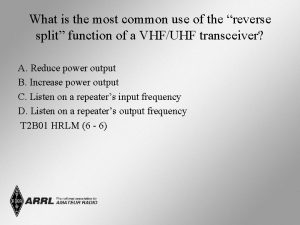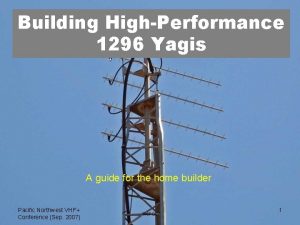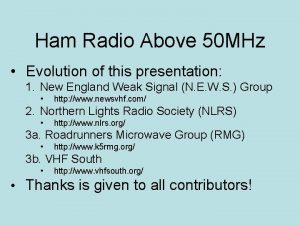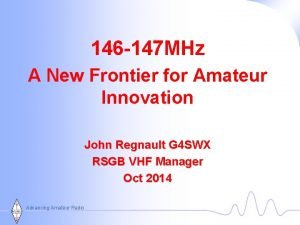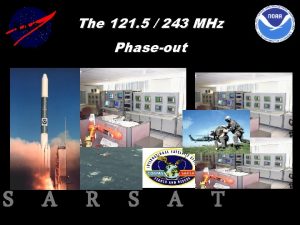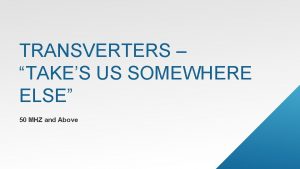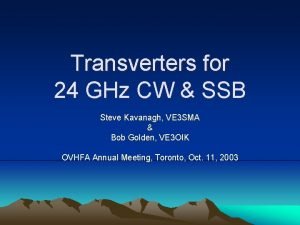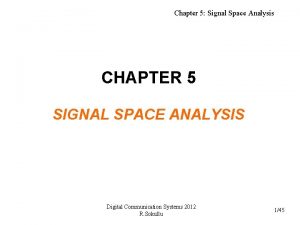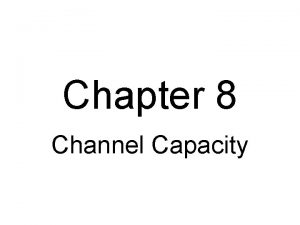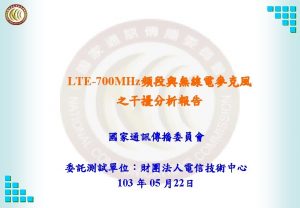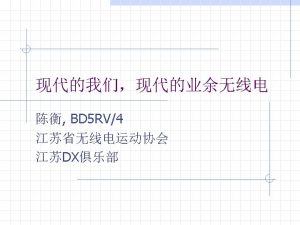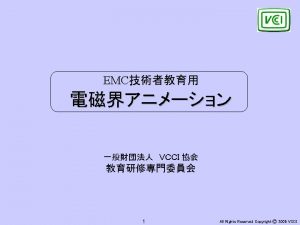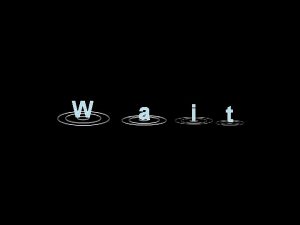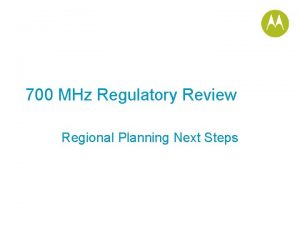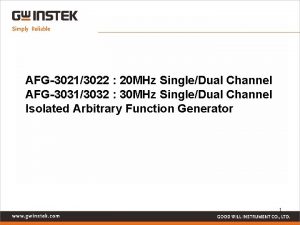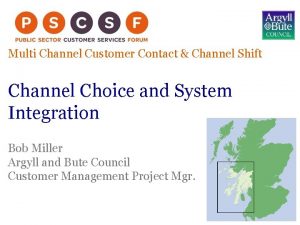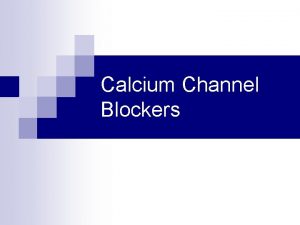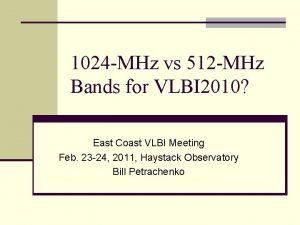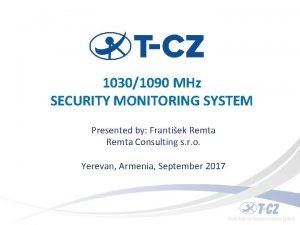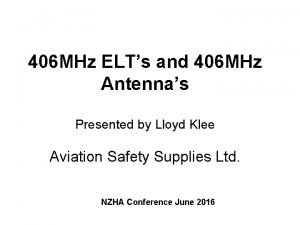CHANNEL LOADING CALCULATOR FOR 700 MHz Regional Planning




















- Slides: 20

CHANNEL LOADING CALCULATOR FOR 700 MHz Regional Planning Committee Guidance By Joe Kuran Wednesday March 9 th 2016


This Channel Loading Calculator is designed for anybody interested in channel loading Discover a fresh approach on how to determine the minimum number of channels needed. With this calculator you will be able to preserve your valuable spectrum and still deliver optimal radio service.

The main subject at this time will be to focus on how to get valid data that goes into the calculator. For existing system’s airtime is used. That could be 1 radio talking 17 minutes. or 17 radios each talking 1 minute

This empirical date is based on the C 800/WCCCA Motorola 800 MHz simulcast trunking system that covers Clackamas County and Washington Counties in Oregon. Gen. Watch was used to extract the data from the Master Site for the year of 2013.

Based on the following statistics: Agencies = 40 Talk groups = 75 Subscribers = 7500 Push-to-talks = 14 million Airtime = 48 million seconds (1. 5 years) Repeater hang time = 200 m. Sec Erlang C default settings: Go. S (Grade of Service) = 1% Busy Queue waiting time = 1 Second Talk groups have the same priority 12. 5 KHz FDMA/2 -Slot TDMA voice only No Site restrictions Data would be a separate element

Site Originations vs: Site Involvement Data is based on the sum of all PTT’s that originated from all cells

0 CCDISP 1 BV 1 WCSO 1 PROV-1 HB 1 WCSO 2 SC 1 CCDISP 2 LOPD-1 WCJAIL NBPDDISP CCDISP 3 OPS 34 WCF-DISP OPS 24 ST-V CCOMDISP OPS 25 INET CCTAC 1 HBPDREC HB 2 OPS 33 WCLUT 1 LOCOM WCSOTAC 2 WV-BUS-1 MER-PARK BVPDREC WCSOTAC 1 OPS 32 TCH OPS 35 OPS 42 SWPDTAC 1 OPS 37 CCSO-SIU WCCRTSEC CCTAC 2 CCCOURT SRVNET NFDISP NDPDTAC 2 WV-BUS-2 CCTAC 3 BVPDTAC 2 OPS 26 BV 2 BVPDDET CC-F 4 -PATCH BVPDTAC 1 HBPDDET FGPDREC WALAW 1 TIPDTAC 1 PROVNBG IGET CCFTRN 1 SC 2 WASHA COPDDET PARKS-1 KAISERTAN CNBYDET CLACKA SWPW 1 WCSODET DUNOPS WCF-TRN 1 WASHB CCSOSWAT FO-FLAG OPS 39 LOPW 2 System: ALL Zone: ALL Site: ALL 90, 000 Total Airtime Top 75 Talkgroups 80, 000 70, 000 60, 000 Minutes 50, 000 40, 000 30, 000 20, 000 10, 000 Talkgroups

Radios in use per average peak hour per Talkgroup WCSO 1 40. 98 269. 7 6. 59 The peak from each of the 365 days is than averaged

902 Radios Owned by Agency 1 TOTAL Daily (Avg Radios/Hour) averaged for the year 61. 16 WASHINGON COUNTY SHERIFF TALK GROUP BREAKDOWN for 2013 WCSO 1 WCSO 2 WCJAIL WCSOTAC 2 WCSOTAC 1 23. 24 11. 61 20. 40 1. 58 CRTSEC WCSODET WCSO REC 1. 33 2. 59 0. 33 0. 08 Daily (Peak Radios/Hour) averaged for 1 2 year 121. 36 40. 98 23. 04 31. 86 6. 98 6. 18 8. 72 2. 48 1. 13 Daily (Ave PTT/Hour) averaged for the year 339. 36 134. 62 101. 48 75. 01 7. 48 6. 37 10. 94 3. 33 0. 15 269. 65 226. 95 148. 12 44. 58 41. 46 54. 36 30. 38 2. 65 351, 051 254, 999 60, 472 2, 643 3 4 5 6 7 8 9 10 11 Daily (Peak PTT/Hour) averaged for 1 year 818. 15 Total Airtime for the year secs 11, 342, 881 4, 507, 236 3, 398, 815 2, 359, 831 407, 835 Total PTT for the year 2, 928, 434 Ave PTT per radio per hour(in 1 year period) 4. 71 5. 77 Peak PTT/radio/hour(in 1 year period) 6. 23 Ave PTT duration(in 1 year period) secs 4. 41 Peak PTT duration(in 1 year period) secs Airtime minutes per hour 23. 34 1, 179, 230 888, 985 657, 050 65, 327 55, 626 70, 861 10, 712 643 8. 71 3. 66 4. 68 3. 97 4. 39 1. 82 6. 59 9. 97 4. 67 6. 49 6. 64 5. 93 7. 47 2. 09 3. 82 3. 83 3. 59 6. 40 6. 35 3. 60 3. 90 3. 83 32. 98 34. 57 17. 20 36. 43 34. 19 17. 25 8. 95 5. 18 17. 18 14. 47 8. 86 4. 75 4. 39 3. 26 1. 98 0. 17 Than the total for each Talkgroup from each agency is either summed or averaged Standard Deviation for WCSO 1 Peak Radios/Hour = 5. 3 Standard Deviation for WCSO 1 Peak PTT/radio = 0. 9

Than the channel loading from each Talkgroup was calculated. TRUNKING SYSTEM CHANNEL LOADING CALCULATOR Based on Erlang C due to queue 1 2 3 4 5 6 7 8 WCSO 1 WCSO 2 JAIL TAC 2 TAC 1 CRTSEC DET REC TOTAL AVE 902 902 902 Ratio of Active Radios to Radio Owned 4. 54% 2. 55% 3. 53% 0. 77% 0. 69% 0. 97% 0. 27% 0. 12% 13% Actual Radios in use per Hour 41. 0 23. 0 31. 9 7. 0 6. 2 8. 7 2. 5 1. 1 121 6. 6 10 4. 7 6. 5 6. 6 5. 9 7. 4 2. 0 6. 2 41. 5 54. 4 30. 4 2. 6 818 6. 3 3. 6 3. 9 3. 8 4. 4 Trunking System, Erlang C due to queue AGENCY TALKGROUPS Total Radios owned by Agency PTT's per radio Total Number of PTT per hour PTT Duration in Seconds Erlangs 269. 6 226. 9 148. 1 44. 6 3. 8 Performance Objectives Go. S P(W>W 0) Offered Traffic Characteristics Call traffic (Erlangs) Average Holding Time 6. 4 0. 2863 0. 2412 0. 1476 0. 0792 0. 0731 0. 0544 0. 0329 0. 0028 0. 9175 reference waiting time queue in sec (W 0) 3. 6 1 1% 0. 92 4. 41 second(s) Busies of 1 second or less are considered acceptable. This time is user determined 1 busy over 1 second per 100 PTT's is considered acceptable. Grade of Service is user determined second(s) FDMA TDMA 4 3 Probability that a call has to wait 1. 53% Probability that call will not be handled immediately Probability that a call has to wait more than W 0 0. 76% If the Go. S of 1% is entered in line 15, than any thing 1 second or under is considered acceptable. System Type Frequencies Needed Assuming 12 KHz channel bandwidth and 2 -Slot TDMA in 12. 5 KHz channel Frequencies include FDMA control channel

Note: CCSO includes Sheriff radios plus all local police in Clackamas County


Reference based on Empirical data from multiple agencies Key #: 6 PTT’s/radio at 5 sec duration from 600 radios/hour TRUNKING SYSTEM CHANNEL LOADING CALCULATOR REFERENCE SHEET WCFire CCSO WCSO SCPD Talk Groups 9 10 8 7 Column 1 Owned radio Percent 20 Actual PTT's Total Seconds Erlangs radio /radio PTTs /ptt Queue Go. S Erlangs PTT sec Type Freq's Wait>1 Wait<1 BPD 7 HPD 6 PW 2 NBFD LOPD H-Sec Bus TOTAL AVE 3 4 2 2 60 1112 1009 902 360 334 273 188 148 107 55 41 4529 92 125 121 42 56 51 14 30 28 24 15 600 4 6 6 6 10 6 4 4 5 7 7 398 805 818 257 559 325 55 120 143 178 101 3775 7 5 4 5 5 5 4 6 4 4 4 0. 7 1. 1 1. 0 0. 4 0. 7 0. 5 0. 1 0. 2 0. 1 5. 2 8% 12% 13% 12% 17% 19% 8% 20% 26% 43% 38% 13% 6 5 1 1% 5. 2 5 FDMA TDMA 12 KHz B/W and 2 -Slot TDMA in 12. 5 KHz ch 12 7 Frequencies include FDMA control channel 1. 6% 0. 5% Probability Busies of 1 second or less acceptable. 1 busy over 1 sec per 100 PTT's All talkgroups are at the same priority level


67 radios in use per hr/talk path. 67 x 6 PTT x 5 sec = 33. 5 minutes of airtime per talk path per hour. About 50% max loading per talk path. 32 This system would require 15 talk paths: 16 freq FDMA or 9 freq TDMA FDMA 27 Frequencies Needed 22 1750 radios 17 needed 16 freq 12 9 freq needed 1950 radios TDMA When Go. S exceeds 1% channel is added 7 1000/15 talk paths = 67 radios/talk path 2 0 500 1000 1500 2000 2500 Radios in use per hour 3000

This example assumes 25% of 4000 radios are active # Radios per freq 700 TDMA 600 500 444 radios per freq 400 FDMA 300 250 radios per 200 100 0 0 500 1000 1500 2000 2500 3000 Radios in use per hour per freq

The WCCCA Central simulcast provides the majority of the coverage for the WCSO (Washington County Sherriff’s Office) subscribers and home of the WCCCA dispatch center. The C 800 Central simulcast provides the majority of the coverage for the CCSO (Clackamas County Sherriff’s Office) subscribers and home of C 800 dispatch center. The ATIA data discovered that about 95% of the WCSO radios originated their calls on the WCCCA Central simulcast system and that about 97% of the CCSO radios originate their calls on the C 800 Central Simulcast system. This data is what was used to provide PTT count for this study. Now the ATIA data revealed that about 81% of the 95% WCSO calls were involved on the C 800 system and that about 95% of the 97% CCSO calls were in involved on the WCCCA system. Since the C 800/WCCCA system has no site restrictions, it allows all units/talkgroups to access all sites. Digging deeper into the data reveals that there is the small amount of involvement on all the calls for a majority of originated calls.

Dispatcher Radio Involvement time WCSO 1 Dispatch • 41 Radios Per Hour • 7 PTT’s per radio per hour • 4 seconds duration per PTT • 41 times 7 = 287 PTT’s per hour • 287 times 4 seconds = 1, 148 seconds = 19 minutes of airtime per hour • Assume 3 PTT’s per conversation = 287/3 = 96 conversations per hour • Each conversation = 4 seconds times 3 PTT’s = 12 seconds airtime per conversation Add 1 seconds per PTT to pick up mic, etc = 12 + 3 = 15 seconds per conversation. • Add 10 sec for dispatcher to update CAD entries. 15 + 10 = 25 sec per conversation Dispatcher involvement = 96 conversations x 25 sec = 40 minutes per hour

References This basic layout would not have been possible without all the help from Guy Jouannelle at Televate LLC. Final report of the PSWAC (Public Safety Wireless Advisory Committee) 1996 Page 702 has some calculations that predicted future busy hour airtime. It states that each officer would generate 3. 7 minutes of airtime per hour. In contrast, my data for WCSO 1 shows 41 officers(radios) each generating 7 PTT’s per hour at 3. 8 seconds each. That results in each officer generating 27 seconds per hour. And that one message is comprised of (3) three (5) five second transmissions. Interesting that the data in this document refers to the book by Garry G. Hess. Land-Mobile Radio System Engineering by Garry G. Hess 1993 Chapter 13 in this book addresses engineering aspects of a radio system’s capacity to carry messages, or radio traffic. The message times per call were based on early 90’s data. This was before the wide spread use mobile data and cell phones and telephone interconnect on the trunking system. The author believes that today’s call lengths are much shorter and therefore more users per channel is possible. Many thanks to EF Johnson. http: //go. efjohnson. com/systemdesign
 Perbedaan single loading dan double loading
Perbedaan single loading dan double loading Static and dynamic class loading in java
Static and dynamic class loading in java Where may ssb phone be used in amateur bands above 50 mhz?
Where may ssb phone be used in amateur bands above 50 mhz? 25 mhz band
25 mhz band 1296 mhz loop yagi
1296 mhz loop yagi Dx maps 50 mhz
Dx maps 50 mhz 147 mhz
147 mhz 121,5 mhz
121,5 mhz A benchmark program is run on a 40 mhz processor
A benchmark program is run on a 40 mhz processor 630 meter transceiver
630 meter transceiver 24 ghz transverter
24 ghz transverter Single channel marketing definition
Single channel marketing definition Signal space analysis in digital communication
Signal space analysis in digital communication Jfet self bias configuration
Jfet self bias configuration Delineation of formal region
Delineation of formal region Regional planning champaign il
Regional planning champaign il Location planning management
Location planning management Southern nevada regional planning coalition
Southern nevada regional planning coalition Channel capacity planning
Channel capacity planning New product planning and the channel management
New product planning and the channel management Channel capacity planning
Channel capacity planning


